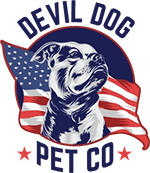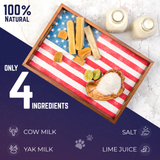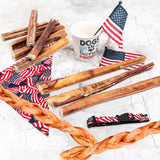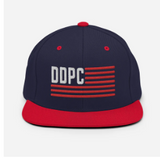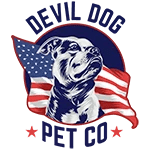The Truth About Puppy Pads: A Marine's No-Nonsense Guide
Let me tell you about the first time our dog Dexter encountered puppy pads. We'd just brought him home, this bundle of energy with zero concept of bathroom etiquette. My wife Amanda suggested puppy pads, and I—fresh out of the Corps and used to direct approaches—scoffed. "Real dogs go outside." Three puddles on our new hardwood later, I was at the store buying every puppy pad they had.
That humbling experience taught me something crucial: successful dog ownership isn't about ego—it's about using the right tools for the mission. And sometimes, that mission involves puppy pads.
Whether you're house-training a new puppy, managing an elderly dog's incontinence, or living in a high-rise apartment, puppy pads can be the difference between sanity and carpet replacement. But like any piece of equipment, you need the right type for your specific operation.
Understanding Your Puppy Pad Mission

Before you drop cash on puppy pads, identify exactly what problem you're solving. This isn't just about buying something to soak up pee—it's about creating a consistent training system that works for both you and your dog.
When Puppy Pads Make Tactical Sense
- You live in an apartment several floors up
- Your work schedule means limited outdoor breaks
- You're dealing with a senior dog's incontinence
- Your area experiences extreme weather conditions
- You have a puppy still developing bladder control
I've seen too many dog owners surrender their pets to shelters because they couldn't manage house training. That's a failure of leadership, not the dog. Puppy pads aren't admitting defeat—they're a strategic tool in your training arsenal.
Disposable vs. Washable Puppy Pads: Choose Your Weapon
Like choosing between standard-issue and custom gear, your puppy pad choice matters. Each has distinct advantages depending on your situation.
Disposable Puppy Pads: The Quick-Deploy Option
Think of disposable puppy pads as your MREs—convenient, ready to use, and easily discarded. They typically feature multiple layers: a leak-proof bottom, absorbent middle, and quick-drying top layer. Some even include built-in attractants to help your dog identify their designated bathroom area.
Our customers with new puppies often start here because they're dealing with frequent accidents during those early training weeks. The convenience factor is high—just pick up, roll, and toss.
Washable Pee Pads: The Sustainable Long-Term Solution
Washable pee pads are your investment gear—initially more expensive but delivering long-term value and reduced environmental impact. These reusable puppy pads typically feature multiple fabric layers with waterproof backing and can withstand hundreds of washes.
When one of our customers transitioned her elderly Labrador to washable pee pads, she calculated saving over $300 annually compared to disposables. That's significant operational cost reduction.
Dog Urine Mats: The Specialized Equipment
For dogs with specific needs, specialized dog urine mats offer enhanced features. These pet pads often include:
- Extra-thick absorbent layers for heavy wetters
- Reinforced edges to prevent leaking
- Non-slip backing for active dogs
- Odor-neutralizing technology
One customer with a senior Boxer with incontinence swears by these specialized mats, noting they've preserved her hardwood floors while maintaining her dog's dignity in his golden years.
Sizing Your Puppy Pad Deployment Area
Size matters when it comes to puppy pads. Too small, and you're setting up for failure; too large, and you're creating confusion about boundaries.
Standard Sizing Guidelines
- Small breeds/puppies: 17" x 24" standard pads
- Medium breeds: 22" x 28" large pads
- Large breeds: 26" x 30" XL pads
- Giant breeds or multiple dogs: 27.5" x 44" XXL pads
Remember, these are starting points. Our dog Dexter quickly outgrew standard pads, and we learned to size up rather than clean up. When in doubt, go bigger—especially during initial training.
Tactical Deployment: Setting Up Your Puppy Pad Station

Location and setup are critical for success. This isn't random—it's strategic positioning.
Optimal Placement Principles
Choose your location with these factors in mind:
- Easy access for your dog
- Away from food and water
- On hard flooring rather than carpet when possible
- Consistent location to build habit
- Semi-private but not isolated
One of our most successful customers created a designated "bathroom corner" in her laundry room with washable pee pads for pets secured in a low-sided plastic tray. This defined the space clearly for her puppy while containing any potential mess.
Securing Your Perimeter
Puppy pads aren't much use if they're constantly bunched up or sliding around. Consider these anchoring techniques:
- Puppy pad holders or trays
- Double-sided tape for temporary setups
- Weighted edges for persistent pad-flippers
- Frame systems for washable puppy pee pads
For particularly playful puppies who see pads as toys, a frame system is worth the investment. It prevents the frustrating cycle of pad destruction that can derail training progress.
Training Protocol: Making the Pads Work
Having the equipment doesn't guarantee success—you need proper implementation. This is where leadership matters most.
The Introduction Phase
When introducing puppy pads:
- Place your puppy on the pad during likely potty times (after sleeping, eating, or playing)
- Use a consistent command like "Go potty"
- Reward successful use immediately with praise and treats
- Never punish accidents—redirect instead
Consistency builds habits. One customer created a potty schedule for her Dachshund puppy, setting alarms for regular pad visits. Within two weeks, her puppy was seeking out the pads independently.
Remember, puppy pads aren't just products—they're tools in your leadership toolkit. Whether you choose disposable convenience or washable sustainability, the right puppy pad system can transform house training from a stress point to a success story. In Part 2, we'll cover advanced techniques for transitioning from pads to outdoor potty training and solutions for common puppy pad problems.
Puppy Pad Tactics for Special Situations
During my time in the Marines, I learned that every mission requires adapting to changing conditions. The same applies to puppy pads. Different dogs and living situations demand different approaches—there's no one-size-fits-all solution when it comes to potty training.
Pee Pads for Old Dogs: Dignity in Senior Years
When our dog Dexter entered his senior years, we faced new challenges with occasional accidents. Many owners mistakenly punish older dogs for these incidents, not realizing they stem from physical changes, not disobedience. Senior dogs often develop incontinence due to weakening muscles, medication side effects, or cognitive decline.
For senior dogs, washable pee pads for pets offer several advantages:
- More stable footing than slippery disposables
- Higher absorption capacity for overnight use
- Cost-effective for long-term management
- Less environmental waste for extended use
- More dignified appearance in living spaces
One customer with a 14-year-old Beagle strategically placed washable puppy pee pads near her dog's favorite resting spots and by the back door. This simple tactic preserved her floors while maintaining her companion's quality of life.
Apartment Dwellers: Urban Puppy Pad Deployment

High-rise living presents unique challenges for dog owners. When you're 20 floors up, "just one quick trip outside" isn't always feasible. This doesn't mean you're failing as a leader—it means you need to adapt your tactics.
Creating Indoor Relief Stations with Reusable Puppy Pads
For apartment dwellers, consider creating a dedicated station using:
- Dog urine mats with raised edges to contain splashes
- Washable pee pads layered for extra protection
- A plastic tray or frame to clearly define the area
- Privacy screens for dogs that prefer seclusion
A customer in Manhattan successfully trained her Shih Tzu to use a balcony station with reusable puppy pads inside a low-sided plastic container. She maintains outdoor walks for exercise but relies on this setup during bad weather and overnight.
Learn more about combining indoor and outdoor training techniques at Animal Wellbeing Centre's guide on using puppy pads and outdoor potty training together.
Balancing Indoor Pads with Outdoor Training
The goal for most owners is to eventually transition primarily to outdoor bathroom breaks. Maintain this balance by:
- Keeping consistent outdoor walking schedules
- Using different commands for indoor pads vs. outdoor elimination
- Gradually reducing indoor pad area as outdoor reliability improves
- Maintaining pads as backup for emergencies or extreme weather
This isn't contradictory training—it's tactical flexibility. Dogs can absolutely learn context-specific behaviors when you provide clear leadership.
Advanced Puppy Pad Strategies
Once you've established basic puppy pad use, it's time to implement advanced techniques to maximize effectiveness and minimize problems.
Preventing the Shred-and-Destroy Mission
Some puppies view puppy pads as exciting toys to be destroyed. This isn't defiance—it's natural puppy behavior that requires redirection. Combat this by:
- Using heavier washable puppy pads that resist tearing
- Securing pads in commercial holders or frames
- Providing appropriate chew toys nearby
- Supervising initial interactions with new pads
- Using bitter apple spray on pad edges for persistent chewers
A customer with a Lab puppy solved her pad-shredding problem by switching to washable pee pads secured in a plastic frame. The investment paid for itself within weeks by eliminating the constant replacement of destroyed disposables.
Multi-Dog Households: Specialized Deployment
- Provide multiple pad stations in different areas
- Consider dog urine mats with higher capacity for multiple users
- Use washable pet pee pads in high-traffic zones
- Create separate stations for puppies and seniors
One family with three dogs of different ages created a designated "bathroom zone" in their mud room with multiple washable pee pads arranged in a larger containment area. This centralized approach maintained household order while accommodating each dog's needs.
Maintenance and Hygiene Protocols
Proper maintenance isn't just about cleanliness—it's about health, training effectiveness, and household harmony.
Disposable Pad Rotation Schedule
For disposable puppy pads:
- Replace immediately after soiling when possible
- Change at least twice daily even with minimal use
- Never allow pads to become saturated
- Clean underlying floor weekly with enzymatic cleaner
Allowing soiled pads to remain creates confusion about appropriate bathroom areas and can lead to avoidance of the pad altogether.
Washing and Maintaining Reusable Pee Pads
For washable puppy pads:
- Keep 2-3 in rotation for continuous availability
- Rinse immediately after soiling to prevent odor lock-in
- Wash in hot water with enzyme-based detergent
- Avoid fabric softeners which can reduce absorbency
- Air dry completely before reuse when possible
A customer who switched to washable pee pads for her incontinent Boxer developed an efficient system: each morning, she machine washes the previous day's pads and hangs them to dry while rotating in fresh ones. This simple routine maintains hygiene without excessive effort.
Cost Analysis: Disposable vs. Reusable Puppy Pads

Let's break down the numbers like a tactical assessment:
Disposable Puppy Pad Economics
Average monthly costs for disposable puppy pads:
- Small dog using 3 pads daily: $15-25/month
- Medium dog using 3 pads daily: $20-30/month
- Large dog using 3 pads daily: $25-40/month
- Annual cost range: $180-480 depending on size and quality
Washable Puppy Pad Investment
Initial investment and operating costs for washable pee pads:
- Initial purchase (set of 4): $30-60 depending on size and quality
- Additional laundry costs: Approximately $5-10/month
- Replacement sets (annually): $30-60
- First-year cost: $90-180
- Subsequent annual costs: $60-120
The math is clear: washable puppy pads typically pay for themselves within 2-4 months of consistent use. For long-term needs like senior dog care or permanent indoor potty solutions, the savings are substantial.
A customer managing her elderly Golden Retriever's incontinence calculated saving over $350 in the first year after switching to high-quality washable pet pee pads. That's not just good economics—it's smart leadership.
Environmental Impact Assessment
Beyond cost, consider the tactical footprint:
- Average disposable pad user generates 1,000+ pads of landfill waste annually
- Most disposable pads take 500+ years to decompose
- Washable pads reduce this impact by 95% or more
- Lower carbon footprint from reduced manufacturing and shipping
This isn't just about being "green"—it's about responsible resource management, a principle any Marine understands.
This detailed guide on potty training dogs offers additional insights: Scott Brand's Guide to Potty Training Dogs.
In the final analysis, your puppy pad selection should align with your specific mission parameters: your dog's needs, your living situation, your budget, and your values. Whether you opt for the convenience of disposables or the sustainability of washables, success comes from consistent implementation and clear leadership. In our next segment, we'll cover transitioning strategies and solutions for the most challenging puppy pad scenarios.
Mastering Puppy Pad Transitions: The Final Phase
When our dog Dexter was transitioning from puppy pads to outdoor-only elimination, I applied the same methodical approach we used for mission phase-outs in the Corps. Gradual, intentional changes beat abrupt shifts every time. Your leadership during transitions determines whether your dog succeeds or struggles.
Moving From Indoor Puppy Pads to Outdoor Only
This transition requires patience and consistency—rushing creates confusion and setbacks. Follow this tactical approach:
- Gradually move puppy pads closer to the exit door over 1-2 weeks
- Reduce the number of available pads, concentrating on the exit location
- Increase outdoor opportunities while maintaining the indoor option
- Heavily reward outdoor elimination with high-value treats and praise
- Remove indoor pads only after 2+ weeks of consistent outdoor success
A customer with a Yorkie puppy successfully completed this transition by moving her reusable puppy pads one foot closer to the door every three days. By week three, the pup was heading to the door independently when he needed to go.
For an in-depth look at potty pad training techniques, see this expert resource: The Ins and Outs of Potty Pad Training - AKC.
Troubleshooting Common Puppy Pad Problems
Even the best-planned operations encounter obstacles. Here's how to overcome the most common puppy pad challenges:
The Missing-the-Target Dilemma
When dogs consistently miss the edge of puppy pads:
- Size up to larger pads or create a grid of multiple pads
- Use washable pee pads with darker colors that clearly define the target area
- Install commercial pad holders with raised edges
- Create a contained area using washable pet pee pads inside a plastic tray
- For males that lift legs, add vertical targets with dog urine mats on walls
One customer solved her male Schnauzer's accuracy issues by creating a three-sided station using waterproof dog urine mats attached to a shower board backdrop. This simple modification achieved nearly 100% success rate overnight.
The Pad Avoidance Problem
When dogs actively avoid using puppy pads:
- Check for residual cleaning chemical odors on the pads
- Try different brands or materials (some dogs dislike certain textures)
- Return to early training basics with constant supervision
- Use attractant sprays specifically designed for potty training
- Place a paper towel with a drop of the dog's own urine on fresh pads
A customer discovered her Poodle was avoiding disposable pads due to the crinkly sound they made underfoot. Switching to silent washable puppy pee pads resolved the issue immediately.
Managing Multiple-Surface Confusion
Dogs sometimes generalize puppy pads to other surfaces like rugs, towels, or bath mats. Combat this by:
- Using distinctly colored washable pee pads that don't resemble household items
- Temporarily removing similar-looking items during training
- Creating clear containment areas for pads using frames or trays
- Never placing pads near similar household textiles
One family solved their Beagle puppy's confusion by selecting bright blue reusable puppy pads that looked nothing like their neutral home décor, creating instant visual distinction.
Special Situations: Travel and Emergency Preparedness

Tactical flexibility means being prepared for non-standard operations—whether that's traveling with your dog or handling emergency situations.
Travel Protocol with Puppy Pads
Even outdoor-trained dogs benefit from puppy pad familiarity when traveling:
- Pack washable puppy pads for hotel stays and unfamiliar environments
- Introduce or refresh pad training before major trips
- Create a portable potty station using pet pads and a familiar-smelling item
- Maintain consistent commands between outdoor and indoor elimination
A customer traveling cross-country with her Lab created a "port-a-potty" using a plastic under-bed storage container lined with washable pee pads. This setup provided consistency at each hotel stop, preventing accidents and reducing stress.
Emergency Preparedness with Puppy Pads
Natural disasters, severe weather, or personal emergencies may prevent normal outdoor access:
- Maintain a supply of washable puppy pads in your emergency kit
- Periodically refresh your dog's pad training with short practice sessions
- Create a designated emergency station location in your home
- Include dog urine mats in your vehicle emergency supplies
After a hurricane left her neighborhood inaccessible, one customer relied on her emergency stock of reusable pee pads for three days until conditions improved. Her advance preparation prevented additional stress during an already difficult situation.
The Final Assessment: Choosing Your Puppy Pad Strategy
Like any mission, success with puppy pads requires clear objectives, proper equipment, and consistent execution. Your specific strategy should align with your dog's needs and your household situation.
For Short-Term Potty Training
If you're using puppy pads temporarily during initial training:
- Either disposable or washable pee pads work well
- Focus on consistent placement and clear boundaries
- Plan your transition strategy from the beginning
- Use pads as a training tool, not a permanent solution
For Long-Term or Permanent Use
If puppy pads will be a permanent part of your dog's life due to living situation or health needs:
- Invest in quality washable puppy pee pads for economic and environmental benefits
- Create permanent, designated stations with proper containment
- Establish a consistent cleaning and rotation protocol
- Consider specialized products like dog urine mats for heavy users
A customer with a 15th-floor apartment created a permanent balcony solution using washable pet pee pads in a custom-built frame. This setup provides her Pomeranian with 24/7 bathroom access while maintaining their walking routine for exercise and enrichment.
Conclusion: Leadership in Every Aspect of Dog Care
Puppy pads aren’t just about convenience—they’re tools for structure, consistency, and clear leadership. Whether training a pup, caring for a senior dog, or adapting to city life, successful pad use reflects intentional dog ownership. At Devil Dog Pet Co., we believe in leading with discipline and flexibility—qualities that turn daily routines into training opportunities. Disposable or washable, pads can serve as stepping stones or long-term solutions. The key is consistency, cleanliness, and confident leadership.
Just as in training or nutrition, success comes from systems that fit your lifestyle. Used correctly, a simple puppy pad reinforces trust, communication, and respect between you and your dog—proving that every detail, even potty habits, matters in strong canine leadership.
Explore Our Recommended Products for Your Puppy Pad Mission
Download the FREE 10-Step Dog Prep Guide
Frequently Asked Questions
Are puppy pads a good idea?
Puppy pads can be a helpful tool for house training, especially for those living in apartments or places without easy outdoor access. They provide a designated spot for puppies to relieve themselves indoors, minimizing messes. However, they should be used thoughtfully as part of a broader training plan to encourage eventual outdoor bathroom habits.
What else can I use instead of puppy pads?
Alternatives to puppy pads include using a designated outdoor potty area, training your puppy to use artificial grass mats, or crate training to encourage holding their bladder. Some owners also use newspapers or washable training mats. Choosing the right option depends on your living situation and your puppy’s temperament.
Do pee pads encourage puppies to pee inside?
Pee pads can sometimes encourage puppies to relieve themselves indoors because they learn that peeing inside is acceptable on certain surfaces. This may make transitioning to outdoor potty training more challenging if not managed carefully. Consistency and gradual training are key to preventing long-term indoor peeing habits.
What attracts puppies to pee pads?
Puppies are attracted to pee pads due to their scent and texture, which can mimic grass or other natural surfaces. Many pads are infused with attractant scents designed to encourage puppies to use them. Additionally, the absorbent material helps keep the area dry, making it more appealing for repeated use.
Do puppy pads delay potty training?
Using puppy pads can sometimes slow down the potty training process if a puppy becomes too reliant on them and doesn’t learn to associate outdoor elimination with positive outcomes. However, with proper guidance and a clear transition plan, pads can be a temporary aid without causing significant delays. The key is to gradually phase out the pads and reward outdoor bathroom behavior.
How to train a dog to pee outside after a pee pad?
To transition your dog from pee pads to outdoor pottying, start by moving the pads closer to the door, then eventually outside. Encourage and reward your puppy with treats and praise whenever they pee outdoors. Be patient and consistent, and avoid punishment for accidents, as positive reinforcement helps make the process smoother and more effective.
